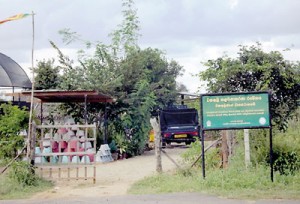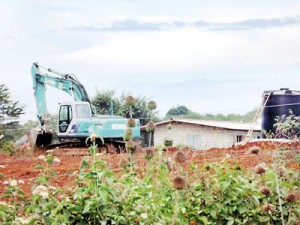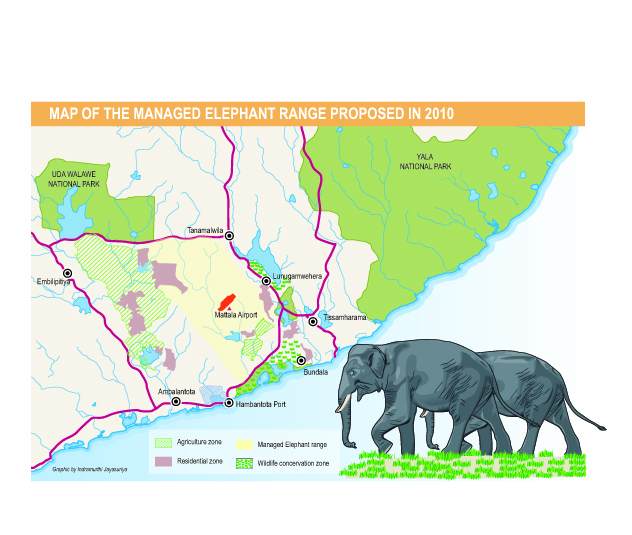News
Jumbos cry for a home on the range
A proposal to set up a Managed Elephant Range (MER) around Mattala Airport in Hambantota area has failed to get off the ground, sparking  fears of intensified human-elephant conflict.
fears of intensified human-elephant conflict.
Four years after the demarcation of the range it has not been gazetted unlike neighbouring sanctuaries, and thus there is no way the Wildlife Department can legally enforce protection of the animals by taking action against encroachers.
“There are factories, farms and cultivations, private companies, illegal houses as well as government organisations in the reserve,” said environmentalist and researcher Supun Lahiru Prakash. “There are about 50 mining quarries, including one run by the army.”
Mr. Prakash said humans had encroached on more than 400 hectares of the proposed MER, the first reserve to be designed according to detailed research into elephant roaming patterns.

People have taken over the reserve area
But in the absence of legal sanctuary for the animals, Mr. Prakash said, the Wildlife Department could only erect billboards and electric fences around the park in a futile attempt to deter encroachers.
In August, Mr. Prakash said, a woman engaging in cultivation inside the reserve had been killed by an elephant.
The Hambantota area is home to about 400 elephants, a tenth of the species’ population in this country.
When the area was chosen for development the authorities tried to translocate the animals and carried out two major elephant drives to Lunugamvehera National Park in 2005 and 2006, yet the elephants returned, as research shows elephants do not like to leave their birthplace.
In 2010, based on the results of research into the animals’ ranging patterns, a decision was taken to allocate elephant space under the Greater Hambantota Development Plan by setting aside territorial areas of the local herds as an MER.
A Wildlife Department official who requested anonymity, claimed the Mahaweli Development Authority, the Sustainable Energy Authority and other development projects were requesting land for development in the reserve area, and members of the public armed with faked deeds were also encroaching.
Wildlife officials were unable to object to any of this because the reserve was not legally protected.
The Wildlife Ranger of Hambantota W.M.A. Gunatunga said the MER was only at the proposal stage and had been at this point since 2010.
He acknowledged that permanent buildings as well as long-term cultivation including coconut plantations had come up in the proposed reserve.
Mr Gunatunga said the Urban Development Authority (UDA) and Road Development Authority (RDA) had marked two elephant passes in the Expressway area and had said they would construct bridges in those areas to help elephants travel to different parts of the reserve.
The Centre for Conservation and Research, headed by noted conservationist Dr Prithiviraj Fernando, joined with the Wildlife Department to carry out research on the Hambantota elephants’ ranging habits by tracking the elephants through collars with beacons.
Dr. Fernando said the Wildlife Department and environmental authorities had accepted in 2010, based on the research, that the reason for the lack of success in elephant drives was that elephants hesitated to leave their birthplace.
He said that the research data was used by the Urban Development Authority (UDA) for drawing up the parameters of the elephant reserve.
Following this, Dr. Fernando said, the Central Environmental Authority had listed sites that could be developed and the areas that should not be developed.
“People are claiming land illegally due to the increasing facilities in Hambantota and they are distorting the planning that was carried out for the betterment of both man and beast,” said Dr. Fernando.
Wildlife Department Director-General H.D. Ratnayake said Hambantota elephants visited the Bundala and Lunugamvehera reserves but did not regard these as their permanent home.
“They live in Hambantota. Besides, other parks are surrounded with electric fences so elephants cannot go into them and if they were moved from their natural habitat they will not survive,” Mr. Ratnayake said.
‘We are continuing to put our boards and electric fences around the reserve that is proposed, yet the land is not ours. We cannot take any further action without the gazette which legally transfers the land to us,” he added.
“Bundala, Yala and Lunugamvehera are the only reserves to be gazette [in this area],” he said.
The Wildlife Department Director-General said the government should formally demarcate the land as a reserve and make arrangements to gazette it. “Only then can we take action against illegal settlers,” he said.
Wildlife Ministry secretary Udeni Wickremesinghe, said a survey of the land had been carried out and Cabinet and Parliament needed to implement the proposal for the Managed Elephant Range.

